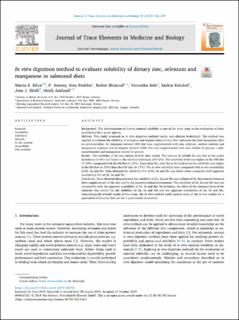| dc.contributor.author | Silva, Marta Sofia | |
| dc.contributor.author | Antony Jesu Prabhu, Antony Jesu Prabhu | |
| dc.contributor.author | Ørnsrud, Robin | |
| dc.contributor.author | Sele, Veronika | |
| dc.contributor.author | Kröckel, Saskia | |
| dc.contributor.author | Sloth, Jens Jørgen | |
| dc.contributor.author | Amlund, Heidi | |
| dc.date.accessioned | 2021-03-04T13:30:23Z | |
| dc.date.available | 2021-03-04T13:30:23Z | |
| dc.date.created | 2020-02-03T16:32:52Z | |
| dc.date.issued | 2020 | |
| dc.Published | Journal of Trace Elements in Medicine and Biology. 2020, 57 152-159. | |
| dc.identifier.issn | 0946-672X | |
| dc.identifier.uri | https://hdl.handle.net/11250/2731678 | |
| dc.description.abstract | Background
The determination of dietary mineral solubility is one of the main steps in the evaluation of their availability for a given species.
Methods
This study proposed an in vitro digestion method (acidic and alkaline hydrolysis). The method was applied to evaluate the solubility of inorganic and organic forms of zinc (Zn), selenium (Se) and manganese (Mn) in salmonid diets. An inorganic mineral (IM) diet was supplemented with zinc sulphate, sodium selenite and manganous sulphate and an organic mineral (OM) diet was supplemented with zinc chelate of glycine, l-selenomethionine and manganese chelate of glycine.
Results
The solubility of Zn was similar in both diets tested. The amount of soluble Zn was low in the acidic hydrolysis (3–8%) and lower in the alkaline hydrolysis (0.4–2%). The solubility of Se was higher in the OM diet (7–34%) compared with the IM diet (3–12%). Regarding Mn, after the acidic hydrolysis the solubility was higher in the IM diet (6–25%) than the OM diet (4–17%). The in vitro solubility were compared with in vivo availability of Zn, Se and Mn. Data obtained for solubility (%) of Zn, Se and Mn was lower when compared with apparent availability (%) of Zn, Se and Mn.
Conclusion
Data obtained demonstrated that solubility of Zn, Se and Mn was influenced by the mineral chemical form supplemented to the diet and by the gastrointestinal environment. The solubility of Zn, Se and Mn was not comparable with the apparent availability of Zn, Se and Mn. Nevertheless, the effect of the chemical form of the minerals was similar for the solubility of Zn, Se and Mn and the apparent availability of Zn, Se and Mn. Considering the overall results of this study, the in vitro method could replace some of the in vivo studies for a qualitative evaluation but not for a quantitative evaluation. | en_US |
| dc.language.iso | eng | en_US |
| dc.publisher | Elsevier | en_US |
| dc.rights | Attribution-NonCommercial-NoDerivatives 4.0 Internasjonal | * |
| dc.rights.uri | http://creativecommons.org/licenses/by-nc-nd/4.0/deed.no | * |
| dc.title | In vitro digestion method to evaluate solubility of dietary zinc, selenium and manganese in salmonid diets | en_US |
| dc.type | Journal article | en_US |
| dc.type | Peer reviewed | en_US |
| dc.description.version | publishedVersion | en_US |
| dc.rights.holder | Copyright 2019 The Authors. | en_US |
| dc.source.articlenumber | 126418 | en_US |
| cristin.ispublished | true | |
| cristin.fulltext | original | |
| cristin.qualitycode | 1 | |
| dc.identifier.doi | 10.1016/j.jtemb.2019.126418 | |
| dc.identifier.cristin | 1790416 | |
| dc.source.journal | Journal of Trace Elements in Medicine and Biology | en_US |
| dc.source.40 | 57 | |
| dc.source.pagenumber | 152-159 | en_US |
| dc.relation.project | Norges forskningsråd: 244490 | en_US |
| dc.identifier.citation | Journal of Trace Elements in Medicine and Biology. 2020, 57, 152-159, 126418 | en_US |
| dc.source.volume | 57 | en_US |

